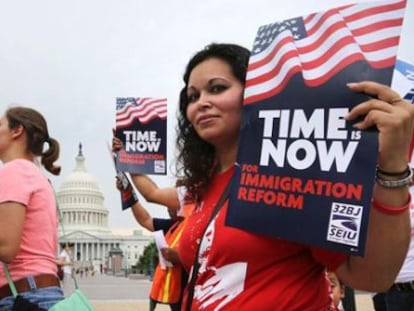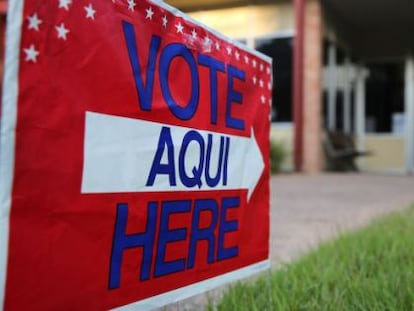Could California become independent after Trump victory?
Secessionist group in US state has pushed forward vote plans after recent presidential election

A hypothetical referendum on California’s independence has a date: March 13, 2019. The probability that the plebiscite will actually take place is currently minimal, but proponents are banking on a fresh wave of support following the victory of a presidential candidate who is widely despised in California, where over six million people voted against Donald Trump.

On Monday, a group called Yes California officially submitted a citizen initiative to the state attorney’s office. If the proposed ballot measure prospers, Californians would ultimately be asked to vote for or against secession from the United States.
The initiative proposes to repeal Article III, Section 1 of the California Constitution, which currently says: “The State of California is an inseparable part of the United States of America, and the United States Constitution is the supreme law of the land.”
The proposal also seeks to add a provision to the California Elections Code, to read that on March 13, 2019, the Secretary of State shall submit a question to state voters: “Should California become a free, sovereign, and independent country?”
Independence for California and Texas, the country’s two largest economies, has always been a vague fantasy for fringe groups
The initiative states that the result of the plebiscite will be considered a declaration of independence if at least 50% of registered voters participate, and if yes wins by at least 55%.
In such an event, “the Governor shall carry and shepherd an application for the newly-independent Republic of California to join the United Nations.”
More than fantasy?
Independence for California and Texas, the country’s two largest economies, has always been a vague fantasy for fringe groups.

But Trump’s recent victory could bring a “Calexit” closer to being a reality. On election night, an angry Silicon Valley businessman tweeted that he was ready to bankroll any such initiative.
In California, the Democratic Party controls the governorship and enjoys reinforced majorities in both houses of the state capitol. Hillary Clinton beat Trump here by nearly three million votes.
Yes California’s initiative will now have to be reviewed by the public and by the state, then published officially before the signature collection can begin. The group has already presented nine other initiatives in the past, but none of them secured enough signatures to make it on the ballot.
This time, secessionists will have to collect 585,407 signatures in order to include the initiative on the ballot for 2018 legislative elections. If passed, this would lead to a special plebiscite in March 2019.
Added traction
Trump’s victory could give the movement new traction. On November 14, the cities of Los Angeles and New York held the country’s largest protests against the president-elect. In L.A., tens of thousands of people occupied Wilshire Boulevard, one of the city’s east-west arteries. City officials praised demonstrators.
Meanwhile, state senate and assembly leaders Kevin de León and Anthony Rendon, both Hispanic, have pledged to do everything possible to defend migrant protection policies in California, the state with the highest number of immigrants in the US.
And Governor Jerry Brown has already warned that California will not relax its policies against climate change, which are among the most stringent in the country.
Ignored two years ago by voters, proponents of Calexit may be facing a more willing audience this time around.
IT'S OFFICIAL. See/Read our #Calexit independence plebiscite on the California Attorney General's website. https://t.co/WGqtKiKZVk? pic.twitter.com/xPpv2ac9vo
— YesCalifornia (@YesCalifornia) November 21, 2016
English version by Susana Urra.
Tu suscripción se está usando en otro dispositivo
¿Quieres añadir otro usuario a tu suscripción?
Si continúas leyendo en este dispositivo, no se podrá leer en el otro.
FlechaTu suscripción se está usando en otro dispositivo y solo puedes acceder a EL PAÍS desde un dispositivo a la vez.
Si quieres compartir tu cuenta, cambia tu suscripción a la modalidad Premium, así podrás añadir otro usuario. Cada uno accederá con su propia cuenta de email, lo que os permitirá personalizar vuestra experiencia en EL PAÍS.
¿Tienes una suscripción de empresa? Accede aquí para contratar más cuentas.
En el caso de no saber quién está usando tu cuenta, te recomendamos cambiar tu contraseña aquí.
Si decides continuar compartiendo tu cuenta, este mensaje se mostrará en tu dispositivo y en el de la otra persona que está usando tu cuenta de forma indefinida, afectando a tu experiencia de lectura. Puedes consultar aquí los términos y condiciones de la suscripción digital.
More information
Archived In
Últimas noticias
There is as much life left to discover on planet Earth as that which is already known
Dozens presumed dead, around 100 injured in fire at Swiss Alps bar during New Year’s celebration
Is porn for women different from conventional porn? We spoke to those who make it
Cartagena de Indias is sinking: What can the city do to mitigate it?
Most viewed
- Sinaloa Cartel war is taking its toll on Los Chapitos
- Reinhard Genzel, Nobel laureate in physics: ‘One-minute videos will never give you the truth’
- David King, chemist: ‘There are scientists studying how to cool the planet; nobody should stop these experiments from happening’
- Oona Chaplin: ‘I told James Cameron that I was living in a treehouse and starting a permaculture project with a friend’
- The Interoceanic Train, the Mexican alternative to the Panama Canal










































